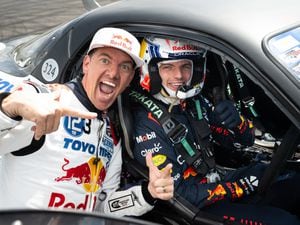What makes the BBC’s Wimbledon theme tune such a perfect piece of sporting music?
You’ll be humming along to this in no time.
As well as being one of the world’s foremost sporting events, Wimbledon has one of the catchiest theme tunes in Keith Mansfield’s Light And Tuneful, used by the BBC.
Since it was first used over 40 years ago, Mansfield’s music has become synonymous with the grass courts, sunshine and Sue Barker, whose face usually appears on our screens after the last trumpets have faded out.
It’s become a national institution in and of itself – hum it in company and you’re sure to have a fully stocked chorus line by the end – but what is it that makes it such a successful sporting theme tune?
Dr Costas Karageorghis is a reader in sport psychology at Brunel University in London, whose research specialism is the application of music in sport and exercise – he says that our enjoyment of the piece has a lot to do with association.
“Most of the power in that tune is down to what we term extra musical association,” he says.
“Through repetition, what we call classical conditioning in psychology – just like Pavlov’s dogs when they heard the bell, the dogs would salivate – in this instance we hear the music and the link between the music and tennis at an elite level is reinforced to a greater and greater degree.”
The piece as a whole then stirs up a deep longing for tennis – but what about the specifics of the music?
Dr Karageorghis believes introduction of loud, immediate brass is one of its key attributes.

And while the intro is a force of nature, other more subtle elements of the music are key to maintaining a sporting vibe.
“Perhaps more significantly the melody is played over a highly syncopated rhythm with a strong back beat, and that in itself gives a sense of energy and movement,” says Dr Karageorghis.
“One of the characteristics that merge the world of music and sport is that both are ludic (spontaneous and playful) activities, and I think that’s captured beautifully within the piece – it has a playful quality to it.”

But something else that’s important, according to Philip Cashian, head of composition at the Royal Academy of Music, is how the music intertwines with the moving images on the screen.
“The energy of it, and how it reflects a game of tennis is important,” says Philip.
“It has that movement, and then it stops, and the ball is being hit and the crowd are clapping into those sections of the theme tune.
“So they’ve actually mapped a game of tennis onto the theme, and it’s got that sense of movement and energy, pausing and then getting going again. It’s very physical.”
And on the subject of sporting themes, Philip points out that there are definitely musical elements you do want to include, as well as those you don’t.
“Orchestration and brass are important,” he says. “You think of all the classic themes like Grandstand and Match Of The Day, you want brass, percussion and bass.
“You don’t want quiet strings, and I think it needs to be quite immediate.”

“What is really interesting about the composition is that it doesn’t seem to lean on any particular musical idiom,” says Dr Karageorghis. “And because of that it has a timeless quality.”
You can read more from Dr Costas Karageorghis in his 2017 book Applying Music in Exercise and Sport.





